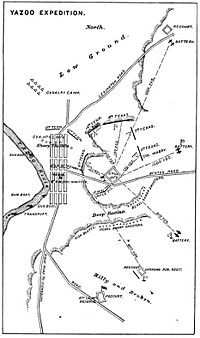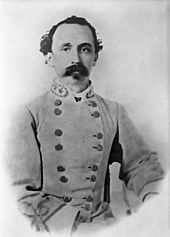Battle of Yazoo City facts for kids
Quick facts for kids Battle of Yazoo City |
|||||||
|---|---|---|---|---|---|---|---|
| Part of the American Civil War | |||||||
 Battle of Yazoo City, March 5, 1864 |
|||||||
|
|||||||
| Belligerents | |||||||
| Commanders and leaders | |||||||
| James Henry Coates | L. S. "Sul" Ross | ||||||
| Strength | |||||||
| 1,200 5 gunboats |
1,300 6 guns |
||||||
| Casualties and losses | |||||||
| 183 | 64 | ||||||
The Battle of Yazoo City happened on March 5, 1864, in Mississippi. It was a fight during the American Civil War. Union (North) soldiers were on a month-long trip up the Yazoo River. Their leader, Colonel James Henry Coates, fought off an attack. The attack was led by Confederate (South) General Lawrence Sullivan Ross. The Union side had more soldiers hurt or captured. They left the area the next day. They took a lot of cotton they found along the river. This trip was part of a bigger plan by Union General William Tecumseh Sherman.
Contents
Why Did the Battle of Yazoo City Happen?
In early 1864, President Abraham Lincoln wanted Union armies to work together. General Sherman was planning a big move in Mississippi. He wanted to destroy Confederate railroads. These railroads were important for moving supplies. Sherman's main army of 25,000 soldiers left Vicksburg, Mississippi on February 3, 1864. They were heading for Meridian. Colonel Coates' group was a smaller part of this larger plan.
The Yazoo River Expedition Begins
Colonel Coates followed orders from his commanders. He put 947 soldiers onto river boats on January 31, 1864. This group included soldiers from the 11th Illinois Infantry Regiment. It also had men from the 8th Louisiana Infantry Regiment (African Descent). The 11th Illinois was an experienced group. They had fought in many big battles before. The 8th Louisiana (African Descent) had mostly done digging work. They were excited to finally be part of a fighting mission.
Five gunboats helped protect the transport boats. They sailed up the Yazoo River. On February 1, they picked up more soldiers. These were cavalry (soldiers on horseback) from the 1st Mississippi Cavalry Regiment (African Descent). The next day, they went about 25 miles (40 km) upriver. They reached Satartia. Some soldiers went ashore and chased away Confederate troops.
Early Skirmishes and Challenges
On February 3, the boats reached Liverpool Heights. Confederate cannons fired at them. Colonel Coates sent half of his soldiers ashore to fight. These troops fought against about 500 Confederate cavalrymen. The land was hilly, making it hard to move. Coates' soldiers struggled to advance. That evening, they got back on their boats. They moved about 1 mile (1.6 km) downstream. The Union side lost six killed, 21 wounded, and eight missing.
On February 4, the boats tried again. They found the Confederate cannons had run out of ammunition. But Confederate soldiers still fired small guns at them. Five Union men were wounded. Two gunboats reached Yazoo City. But they had to leave when more Confederate cannons fired at them. The expedition went back to Liverpool Heights. Coates sent his wounded soldiers back to Vicksburg.
Reaching Yazoo City and Beyond
On February 9, the Union boats moved upriver again. They found Yazoo City empty. The Confederate General Ross's soldiers had left. They went to help fight Sherman's main army. On February 10, more Union cavalry joined Coates in Yazoo City. They had marched overland.
To find out where Ross's soldiers went, another Union general, John Parker Hawkins, scouted east. He went about 50 miles (80 km) to the Big Black River. But he found no sign of Ross. Coates' boats continued upriver to Greenwood. They got there on February 14. Coates sent cavalry toward Grenada. They found out that Confederate General Nathan Bedford Forrest was there.
The Union boats left Greenwood on February 19. As they sailed down the river, they collected many bales of cotton. They reached Yazoo City on February 28. Union cavalry went ahead to check the area for danger.
By this time, Sherman's main army was returning from Meridian. General Ross's Confederate soldiers also came back to the Yazoo City area. They attacked a small group of Union cavalry. Coates noted that his soldiers fought small battles with Ross's cavalry every day.
The Battle of Yazoo City
On March 4, 1864, Coates learned that more Confederate soldiers had joined Ross. These were 550 cavalrymen led by General Robert V. Richardson. Ross reported that their combined force was 1,300 men.
On March 5, the Confederates attacked. By 10:00 AM, they had surrounded the 11th Illinois soldiers. These Union troops were on the east side of Yazoo City. Six companies of the 8th Louisiana (African Descent) moved to help. But they were pushed back into Yazoo City. They used cotton bales to block the main street. Confederates fought their way into town. They fired from houses. But the African-American soldiers held their ground. Fire from the Union gunboats also helped. It stopped the Confederates from taking over the city.
Major McKee sent a small group to find Coates. Ten of these soldiers were captured. But three got away and told Coates that their only cannon was broken.
To defend the town, Coates had soldiers from the 8th Louisiana (African Descent) and the 11th Illinois. He asked for another cannon from the gunboats. A boat cannon was sent ashore. But its crew ran away. A new, braver crew had to be sent to use it. This cannon fired at buildings where Confederates were hiding. Coates said the Confederates had six cannons. These cannons hurt some of the 11th Illinois soldiers. But they did not do much damage in the town.
For four hours, Union soldiers were cut off east of Yazoo City. General Ross demanded that Major McKee surrender three times. McKee refused each time. Ross said he could not promise that African-American soldiers would be treated as prisoners of war. McKee argued about this point.
Ross and Richardson decided not to attack McKee's position directly. Confederates in the town destroyed some Union supplies. They also took some cotton. Around 2:00 PM, Coates ordered an attack. This cleared the Confederates out of Yazoo City. The Confederate force began to leave. McKee led a small attack from his position. This made the Confederates retreat faster. Ross admitted that the African-American troops fought hard. They pushed the Confederates back.
What Happened Next?
On March 6, 1864, Coates received new orders. He was told to load his troops onto steamboats. They were to travel down the Yazoo River. Coates landed his soldiers at Liverpool Heights. Then they marched overland to Vicksburg. Some troops stayed at Haynes Bluff. The Confederates did not chase them.
The Union side lost 31 killed, 121 wounded, and 31 missing. This was a total of 183 casualties. The 8th Louisiana (African Descent) had the most losses. General Richardson reported 64 Confederate casualties.
Coates reported that 1,728 bales of cotton were sent to Vicksburg. General Sherman wrote that all cotton in the South should be burned or taken away. He worried that people trying to get rich from cotton might bribe soldiers.
Sherman's main army reached Meridian on February 14. His troops spent five days destroying railroads. Then they marched to Canton. They stayed there from February 27 to March 3. Finally, Sherman returned to Vicksburg. Meanwhile, another Union general, Smith, was defeated by Forrest in the Battle of Okolona.
Who Fought in the Battle?
Here are the main groups of soldiers who fought in the Battle of Yazoo City.
Union Forces
| Units | Commander | Strength | Losses |
|---|---|---|---|
| 11th Illinois Infantry Regiment | Major George C. McKee | 560 | 26 |
| 8th Louisiana Infantry Regiment (African Descent) | Lieutenant Colonel F. E. Peebles | 387 | 144 |
| 1st Mississippi Cavalry Regiment (African Descent) | Colonel Embury D. Osband | about 250 | 13 |
| United States Navy | Captain Elias K. Owen | 5 gunboats | unknown |
Confederate Forces
| Brigade | Strength | Units | Commander |
|---|---|---|---|
| Texas Brigade Brigadier General Lawrence "Sul" Ross |
750 4 guns |
Escort: Texas company | Lieutenant Rush L. Elkin |
| 3rd Texas Cavalry Regiment | Colonel Hinchie P. Mabry | ||
| 6th Texas Cavalry Regiment | Colonel Jack Wharton | ||
| 9th Texas Cavalry Regiment | Colonel Dudley W. Jones | ||
| 27th Texas Cavalry Regiment | Colonel Edwin R. Hawkins | ||
| Clark's Missouri Battery | Captain Houston King | ||
| Tennessee Brigade Brigadier General Robert V. Richardson |
550 2 guns |
12th Tennessee Cavalry Regiment | Colonel James J. Neely |
| 14th Tennessee Cavalry Regiment | Major James G. Thurmand † | ||
| 15th Tennessee Cavalry Regiment | Colonel Thomas H. Logwood | ||
| Artillery section | Captain Thrall (WIA) |



